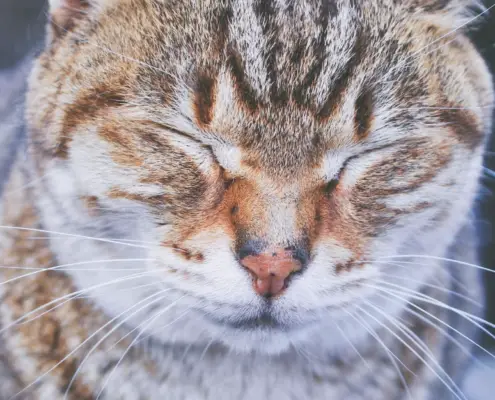
Cats have long been associated with a love for fish. From cartoons to popular culture, the image of a cat eagerly pursuing a fish has become ingrained in our minds. But is this fascination with cats and fish based on reality, or is it just a stereotype? Let’s explore the truth behind a cat’s affinity for fish.
Do cats naturally like fish?
It is commonly believed that cats naturally have a strong liking for fish due to their ancestral hunting instincts. Cats are obligate carnivores, which means that they require a diet primarily consisting of meat. Fish, being a high-quality source of protein, contains essential nutrients that cats need to thrive. This natural preference for meat, including fish, can be traced back to the wild ancestors of domestic cats, who were skilled hunters and relied on consuming small prey, including fish, to meet their dietary needs.
However, it is important to note that not all cats share the same taste preferences. While some cats may indeed have an innate liking for fish, others may show little to no interest in it. Just like humans, cats have individual preferences when it comes to food. Some may prefer poultry, while others may enjoy red meat. This variation in taste preferences can be influenced by factors such as genetics, early experiences, and the specific flavors and textures that a cat has been exposed to throughout their life.
Understanding a cat’s taste preferences
To understand a cat’s taste preferences, it is essential to consider their unique anatomy. Cats have fewer taste buds compared to humans, which means they may not experience flavors in the same way we do. While they can detect basic tastes like sweet, sour, salty, and bitter, their taste buds are particularly sensitive to amino acids, which are the building blocks of proteins. This sensitivity explains why cats are drawn to protein-rich foods like fish.
Additionally, cats have a heightened sense of smell, which greatly influences their perception of food. The aroma of a meal plays a crucial role in enticing a cat to eat. Fish, with its distinct odor, can be highly appealing to cats due to its strong scent. The combination of taste and smell is what ultimately determines a cat’s preference for certain foods, including fish.
The role of fish in a cat’s diet
While fish can be a beneficial addition to a cat’s diet, it should not be the sole source of nutrition. Cats require a balanced diet that includes a variety of protein sources to meet their nutritional needs. Fish, particularly oily fish like salmon or mackerel, provides essential omega-3 fatty acids, which are beneficial for a cat’s skin, coat, and overall health. However, relying solely on fish can lead to nutritional imbalances, as it may lack certain vital nutrients that other protein sources provide.
It is important to consult with a veterinarian to ensure that your cat’s diet is well-rounded and meets their specific nutritional requirements. A veterinarian can provide guidance on the appropriate amount of fish to include in your cat’s diet and recommend other protein sources that will offer a balanced and complete nutritional profile.
Common misconceptions about cats and fish
There are several misconceptions surrounding cats and fish that need to be addressed. One common belief is that cats can eat raw fish just like their wild counterparts. While cats in the wild consume raw prey, domestic cats have different digestive systems and can be susceptible to bacterial contamination or parasites present in raw fish. It is safer to cook fish thoroughly before feeding it to your cat to eliminate any potential health risks.
Another misconception is that cats can subsist solely on fish-based diets. As mentioned earlier, fish alone cannot provide all the necessary nutrients a cat needs for optimal health. A diet solely consisting of fish can lead to nutrient deficiencies and health problems in the long run. Variety is key when it comes to a cat’s diet, and a balanced mix of protein sources ensures a cat receives the necessary nutrients for their overall well-being.
Alternative protein sources for cats
For cat owners who are concerned about relying solely on fish, there are various alternative protein sources available that can provide a well-rounded diet for their feline companion. Poultry, such as chicken or turkey, is a commonly used protein source in cat food and can be easily incorporated into homemade meals. These meats offer a good balance of essential amino acids and other nutrients necessary for a cat’s health.
Red meat, such as beef or lamb, can also be included in a cat’s diet. However, it is important to ensure that the meat is lean and cooked thoroughly to eliminate any potential bacterial contamination. Additionally, organ meats like liver or kidney can be added in small quantities as a source of essential vitamins and minerals.
Plant-based protein sources, such as soy or legumes, can be used as supplementary protein options. However, it is crucial to remember that cats are obligate carnivores, and their bodies are designed to obtain nutrients from animal-based proteins. Plant-based proteins should only be used as supplements and not as the primary source of nutrition.
Introducing fish to your cat’s diet
If you decide to introduce fish into your cat’s diet, it is important to do so gradually and in moderation. Abrupt changes in diet can lead to digestive upset, so it is advisable to transition slowly by mixing small amounts of fish with your cat’s regular food. Monitoring your cat’s response to the new addition is crucial to ensure that they tolerate fish well and do not experience any adverse reactions.
Additionally, it is essential to choose high-quality fish that is free from any additives or excessive sodium. Fresh fish or commercially prepared cat food that contains fish as an ingredient are suitable options. Avoid feeding your cat fish that has been heavily seasoned, fried, or contains bones, as these can pose a choking hazard or cause other health issues.
Signs that your cat may not enjoy fish
While many cats do enjoy the taste of fish, there are instances where a cat may not show enthusiasm for this particular protein source. Just like humans, cats have individual preferences when it comes to food. If your cat displays any of the following signs, it may indicate that they do not enjoy fish:
- Refusing to eat fish-based meals consistently.
- Showing signs of gastrointestinal upset after consuming fish.
- Displaying disinterest or aversion towards the smell or taste of fish.
If your cat exhibits any of these signs, it is best to respect their preferences and explore other protein sources that they may enjoy. Remember, a balanced diet is key, and forcing a cat to eat something they dislike can lead to feeding issues and potential nutrient deficiencies.
Catering to your cat’s individual preferences
As responsible cat owners, it is important to pay attention to our feline companion’s individual preferences and cater to their specific needs. While some cats may have an inherent liking for fish, others may not share the same enthusiasm. The key is to provide a balanced and varied diet that meets their nutritional requirements while considering their taste preferences.
Observing your cat’s response to different flavors and textures can help you determine which protein sources they enjoy the most. Experimenting with different meats and even incorporating small quantities of fish can provide a diverse and stimulating diet for your cat. Remember to consult with a veterinarian to ensure that your cat’s nutritional needs are being met and to address any concerns or questions you may have about their diet.
Conclusion
The fascination with cats and fish is deeply rooted in our perception of these animals. While many cats do have a natural preference for fish, it is important to recognize that not all cats share the same taste preferences. Understanding a cat’s taste preferences, their unique anatomy, and their nutritional requirements is crucial in providing them with a well-rounded and balanced diet.
When introducing fish into a cat’s diet, it should be done gradually and in moderation. Fish can provide essential nutrients and be a valuable addition to a cat’s diet, but it should not be the sole source of nutrition. Consulting with a veterinarian and considering alternative protein sources can help ensure that your cat’s dietary needs are met while catering to their individual preferences.
By taking the time to understand and meet our feline companions’ dietary preferences, we can provide them with a diet that not only promotes their overall health but also satisfies their unique palate. So, while cats may indeed have a natural affinity for fish, it is important to remember that their taste preferences can vary, and it is up to us as responsible cat owners to provide them with a diverse and nutritious diet that suits their individual needs.
If you enjoyed my article, I would appreciate you sharing it with your network.

Sima Ndlebe
Sima writes for CatBuzz. He is interested in Cats, Health and Fitness, and Entrepreneurship.
Published: 30 October 2023



